Famous buildings
Schottenburch
Schottenburch is said to be the oldest existing warehouse in Amsterdam. It is certainly one of the oldest warehouses in the city. Schottenburch has a gable stone with the date 1636, but the building can already be seen on the city map of Amsterdam from 1595 made by Pieter Bast. It is a double warehouse with spout facades and shutters at Kromboomssloot 18–20. Pakhuis de Schottenburch was an artists' initiative from 1979 to 1988. Exhibitions, performances, theater, art events (including "Closer to the Images" and "Art or Pornography?") and music performances were organized by visual artist Wim Vonk, who organized the Schottenburch artists' initiative.
Schottenburch now houses residences, a gallery and a wine trader. [3]
Armenian Apostolic Church
The Armenian-Apostolic Church opened its doors in a former warehouse on the Kromboomssloot in 1714. In 1749 the church was expanded and embellished with, among other things, a frame around the outside door. The church remained in use until 1806. The building was sold in 1874, but in 1989, following the arrival of a new wave of believers from, among others, Turkey, it was bought back and re-used as a church building. In August 2008 a renovation started that would last two years. The upper floors are likely to have a cultural or museum destination. [4] [5] [6]
De Oude Jumbo
De Oude Jumbo is a complex of five contiguous buildings on Kromboomssloot and Oudeschans, four of which (two from the 17th century and two from the 18th century) have been designated as national monuments. In this complex, game manufacturer Jumbo developed well-known games such as Stratego. In 2006, Jumbo left the five buildings and moved to Zaandam. After this, the complex was converted into apartments, whereby the densely built up inner gardens were opened up again and the original rear facades were restored. [7]
De Branderij
The Branderij, the former coffee roasting factory of Alex Meijer & Co., was designed in the early 20th century by architect Emanuel Marcus Rood (1851-1929). The sober art nouveau style building is now a municipal monument. [8]

Gouda is a city and municipality in the west of the Netherlands, between Rotterdam and Utrecht, in the province of South Holland. Gouda has a population of 75,000 and is famous for its Gouda cheese, stroopwafels, many grachten, smoking pipes, and its 15th-century city hall. Its array of historic churches and other buildings makes it a very popular day trip destination.

The Oude Kerk is Amsterdam’s oldest building and newest art institute. The building was founded about 1213 and consecrated in 1306 by the bishop of Utrecht with Saint Nicolas as its patron saint. After the Reformation in 1578, it became a Calvinist church, which it remains today. It stands in De Wallen, now Amsterdam's main red-light district. The square surrounding the church is the Oudekerksplein.

The Singel is one of the canals of Amsterdam. The Singel encircled Amsterdam in the Middle Ages, serving as a moat around the city until 1585, when Amsterdam expanded beyond the Singel. The canal runs from the IJ bay, near the Central Station, to the Muntplein square, where it meets the Amstel river. It is now the inner-most canal in Amsterdam's semicircular ring of canals.
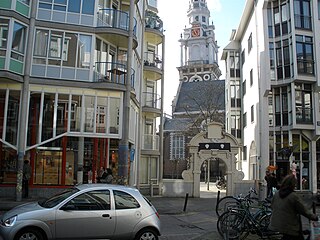
The Sint Antoniesbreestraat is a street in the centre of Amsterdam in the Netherlands. The street runs south from Nieuwmarkt square to the Sint Antoniesluis sluice gates, where it continues as the Jodenbreestraat. The Sint Antoniesbreestraat is primarily a shopping street with a variety of specialty shops. At the corner of Sint Antoniesbreestraat and Hoogstraat is an entry to the Nieuwmarkt stop of the Amsterdam Metro system.

Amsterdam, capital of the Netherlands, has more than 100 kilometers (62 mi) of grachten (canals), about 90 islands and 1,500 bridges. The three main canals, dug in the 17th century during the Dutch Golden Age, form concentric belts around the city, known as the Grachtengordel. Alongside the main canals are 1550 monumental buildings. The 17th-century canal ring area, including the Prinsengracht, Keizersgracht, Herengracht and Jordaan, were listed as UNESCO World Heritage Site in 2010, contributing to Amsterdam's fame as the "Venice of the North".

The Oost-Indisch Huis is an early 17th-century building in the centre of Amsterdam. It was the headquarters of the Amsterdam chamber of the Dutch East India Company. It is a listed Dutch national heritage site (rijksmonument).
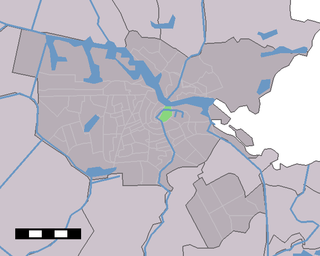
Lastage is a neighborhood in the Centrum borough of Amsterdam, Netherlands. It is located between the Geldersekade and Oudeschans canals, just east of old medieval city. Today, the neighbourhood is also known as Nieuwmarktbuurt due to the fact that the Nieuwmarkt is comprised in the area; it is protected as a heritage site.
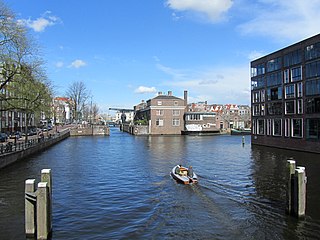
The Nieuwe Herengracht is a canal in Centrum district of Amsterdam. The canal is an extension of the Herengracht that runs between the Amstel and the Scharrebiersluis (lock) leading to the Schippersgracht from the Entrepotdok. It is in the Plantage neighborhood in the eastern part of the Grachtengordel.

The Oudezijds Voorburgwal, often abbreviated to OZ Voorburgwal, is a street and canal in De Wallen in the center of Amsterdam. It runs from the Grimburgwal in the south to the Zeedijk in the north, where it changes into the Oudezijds Kolk, which drains into the IJ.
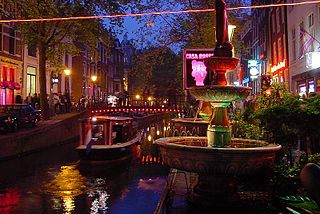
The Oudezijds Achterburgwal, often abbreviated to OZ Achterburgwal, is a street and canal in De Wallen, the red light district in the center of Amsterdam.

The Entrepotdok, formerly Nieuwe Rapenburgergracht, is a canal in Amsterdam, and a street and row of former warehouses with the same name along the northeast side of the canal. They were constructed between 1708 and 1829, used for storage, squatted in the 1990s and are now converted into apartments. Entrepotdok is the largest inhabited warehouse complex in Amsterdam. The canal runs between the Kadijksplein and Sarphatistraat, and is parallel to Hoogte Kadijk, Laagte Kadijk, Plantage Doklaan and Natura Artis Magistra zoo.
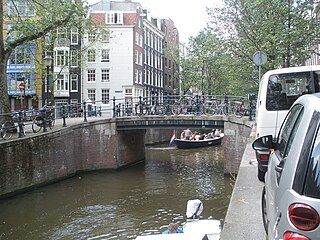
The Rechtboomssloot, or Recht Boomssloot, is a canal in the Lastage (Nieuwmarktbuurt) neighborhood in the center of Amsterdam.

Cornelis Pietersz. Boom was a Dutch landowner and shipbuilder who was involved in various disputes over opening up the Lastage area to the east of Amsterdam. His two sons and one grandson were mayors of Amsterdam.
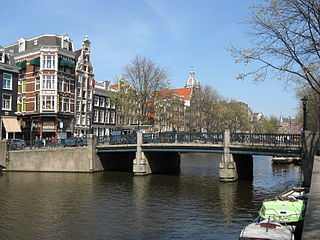
The Geldersekade is a canal and a street in Amsterdam that connects the Nieuwmarkt with the Prins Hendrikkade. The Geldersekade is in the easternmost part of De Wallen, the red light district, and borders Chinatown.

The Oudeschans, or Oude Schans, originally the Nieuwe Gracht, is a wide canal in the eastern part of the inner city of Amsterdam.

The Houtkopersburgwal is a short secondary canal in Amsterdam. It is located in the east of the Amsterdam-Centrum district in the Lastage neighborhood.
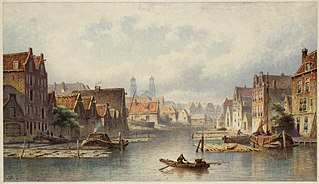
The Uilenburgergracht is a secondary canal in Amsterdam, the Netherlands. It is located east of the Amsterdam-Centrum district, in the Lastage neighborhood.

The Snoekjesgracht is a small canal in Amsterdam, in the Lastage neighborhood.
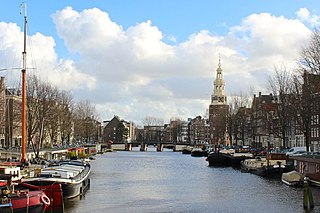
The Waalseilandsgracht, or Waalseilandgracht, is a short, wide canal in the east part of the inner city of Amsterdam.

The Spuistraat in downtown Amsterdam connects the Hekelveld to the Spui. It runs roughly north to south, parallel to the Singel and the Nieuwezijds Voorburgwal. At the Royal Palace of Amsterdam, the Spuistraat crosses the Raadhuisstraat and Paleisstraat. Originally the Spuistraat was a canal, the Nieuwezijds Achterburgwal. The canal was filled in in 1867, and the street renamed then.



























